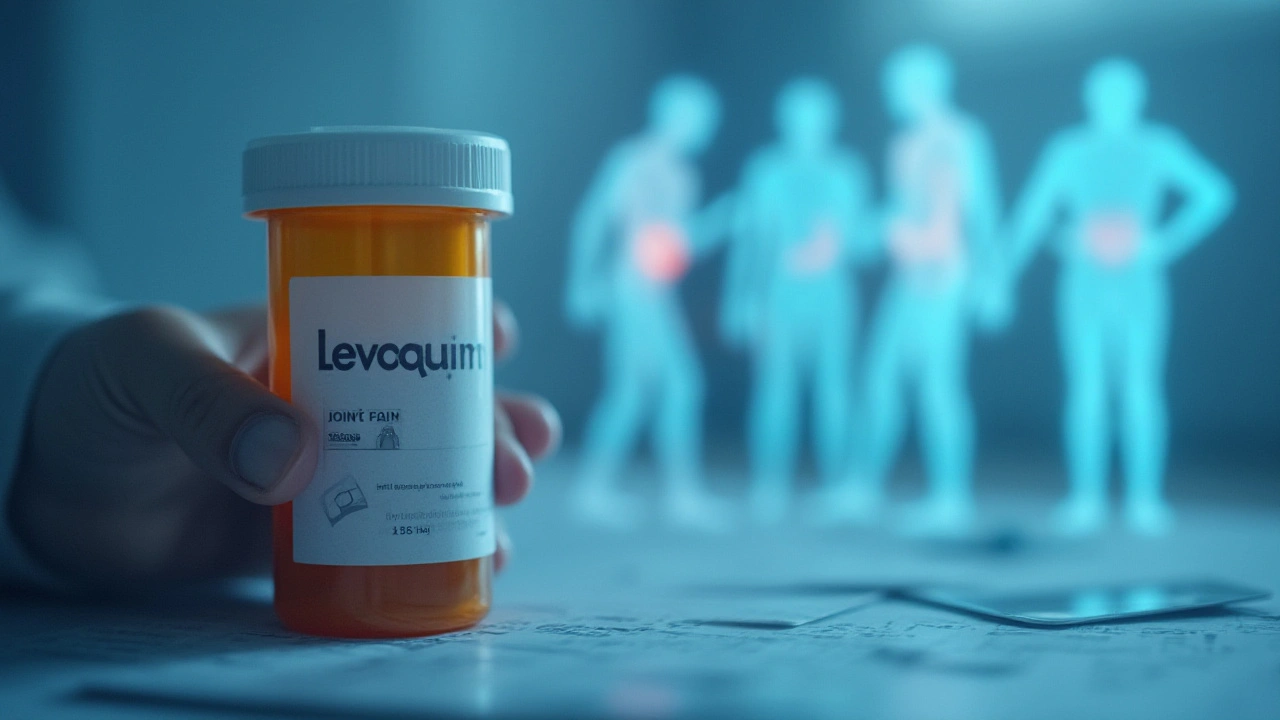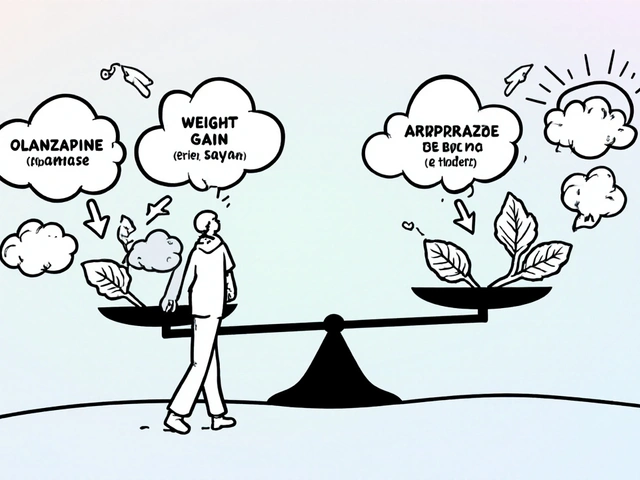
A single pill can knock out a chest infection, but it can also upend your whole body. That’s the double-edged story behind Levoquin, one of the best-known antibiotics in the world. Hospitals rely on it, doctors prescribe it all the time, and if you’ve ever had a nasty sinus infection or relentless bronchitis, you or someone you know might have swallowed one. Still, below its clinical surface, this medicine has a reputation that’s a mix of awe and worry. People have called it a lifesaver—and in rare cases, a troublemaker you never see coming.
What Exactly is Levoquin?
Levoquin isn’t some pharmacy branding trick. It’s the brand name for levofloxacin, a synthetic antibiotic in a class called fluoroquinolones. These antibiotics are heavy hitters: they block bacteria’s ability to copy their DNA, which quickly kills the bugs off. Levoquin got its FDA stamp for medical use in 1996, and by the early 2000s, it was prescribed to millions of Americans every year. Think of it as the muscle in the family, reserved for infections that just don’t back down with regular penicillin or amoxicillin.
Levoquin covers a broad range. It’s approved for battling pneumonia, kidney and urinary tract infections, sinus infections, bronchitis, and a bunch of stubborn skin infections. Doctors also reach for it when treating anthrax exposure and plague. Yes, you read that right—anthrax and plague. That’s how powerful it is. Most doses come in tablet form, but there’s also a liquid option and an intravenous version for people hospitalized with more serious cases.
What makes Levoquin stand out is its reach. It penetrates deep into tissues—lungs, sinuses, and kidneys—places where some weaker antibiotics can’t even get close. It spends a decent amount of time in the bloodstream, with a half-life around 6 to 8 hours, so usually just one pill a day does the trick. And unlike some antibiotics that ruin your day with a dozen side effects, most people just report minor tummy upset or a weird taste in the mouth.
But this drug is no over-the-counter aspirin. You only get Levoquin with a script, and usually only for clear, confirmed bacterial infections. Believe it or not, doctors must be strict. Using Levoquin recklessly raises the risk that bacteria become resistant—and then we’re all left with fewer ways to fight infections down the road.
Quick fact: The 2010 peak saw over 6.7 million US prescriptions, according to IQVIA, a leading health data firm. Over 100 countries have it on their essential medicine lists, mainly because it’s reliable and often cheaper than some alternatives.
When Levoquin Works—And When It Doesn’t
The main thing you need to know: antibiotics like Levoquin don’t do anything for viral infections. Got the common cold or a simple flu? Don’t even bother. Giving a patient Levoquin for a viral sore throat is like using a blowtorch to light a single birthday candle—it’s overkill, and it creates risks without real benefits.
Where it helps is clear-cut: stubborn pneumonia that’s not clearing up, complicated urinary tract infections (especially when you’re dealing with resistant bacteria), and certain cases of sinusitis where doctors suspect bacteria, not allergies, are to blame. It’s also used for prostate infections and, as mentioned earlier, for emergencies like anthrax exposure.
Doctors decide on Levoquin only after weighing the options. In hospitals, they usually order lab tests on your blood or urine so they can see which drugs will wipe out the infection best. In urgent cases, though, there isn’t time to wait days for lab results. That’s often where Levoquin steps in—because it covers dozens of different bacteria that are common culprits in tough infections.
- Pneumonia (both in the community and hospital settings)
- Acute sinus infections caused by bacteria
- Skin infections that don’t respond to basic antibiotics
- Chronic bronchitis flare-ups caused by bacteria
- Complicated urinary tract or kidney infections
- Bacterial prostatitis (infection of the prostate)
- Plague and anthrax exposure (in rare emergency settings)
Studies show that Levoquin clears up uncomplicated urinary tract infections in about 90% of patients after just three to five days. It’s often reserved for people who have allergies to penicillin or other common antibiotics, and is a go-to option for adults with pneumonia who can’t tolerate the basic stuff. For skin infections, it performs nearly as well as IV drugs but allows people to heal at home.
Now here’s the catch: bacteria are clever. The past decade has seen more bug strains grow resistant to fluoroquinolones, especially in hospitals and care homes. This means that sometimes, even Levoquin can’t do the job. That’s why it’s smart for doctors to use it only when truly necessary, saving it for situations where alternatives might flop.

Side Effects: What Most People Feel—and What Some Never Expect
If you’ve ever taken antibiotics, you probably went through a few days of stomach rumbling, perhaps some diarrhea, or a headache that felt like an annoying shadow. With Levoquin, the majority of side effects are in that same mild range. Most people finish their doses without much hassle. Here’s a quick look at what’s common to expect:
- Nausea or queasy stomach (up to 5-10% report this in studies)
- Loose stools or mild diarrhea
- Weird metallic taste in the mouth
- Mild headache or tiredness
- Sometimes light sensitivity
But here’s where things get interesting—and why Levoquin grabs headlines sometimes. Rarely, this drug triggers more serious problems. The U.S. FDA started putting special warnings on all fluoroquinolones, including Levoquin, around 2008, ramping them up again in 2016. The big concerns are tendon ruptures (especially the Achilles tendon), nerve damage that can become permanent, and mental symptoms like sudden confusion, anxiety, or hallucinations (for real).
Tendon issues are strange because they sometimes happen months after the last pill is taken. Most cases show up in people over age 60, or in folks who are taking steroids for other issues. But there are stories of athletic young adults suddenly rupturing their Achilles after a round of Levoquin. If you ever notice pain or swelling around a tendon—like the back of your ankle—while taking Levoquin, call your doctor immediately. Don’t wait.
Other rare risks include serious allergic reactions, severe rashes, or even blood sugar swings in people with diabetes. In a very small group, Levoquin messes with the electrical signals of the heart, causing a condition known as QT prolongation. The result can be a dangerous heart rhythm, especially in people already on certain medications.
Add it up, and most people tolerate Levoquin just fine. But you should never take it like candy. Always tell your doctor about any prior tendon problems, nerve issues, or heart conditions—these are giant red flags. If you’re pregnant or breastfeeding, Levoquin is off-limits. And young kids only get it in very rare, emergency situations.
| Levoquin Side Effect | Reported Frequency |
|---|---|
| Nausea | ~7% |
| Diarrhea | ~5% |
| Tendon Rupture | <0.2% |
| Nerve Damage | <0.1% |
| Mental Status Changes | <0.1% |
Tips for Safe Use—And What to Watch Out For
If you double-check the medicine cabinet in most households, you’ll find at least one dusty bottle of antibiotics that someone didn’t finish. This brings us to the golden rule of Levoquin (and all antibiotics): finish the full course prescribed, even if you start feeling better. Stopping early can let the infection come roaring back—and leave behind the bugs that are toughest to kill.
Take Levoquin exactly as directed—usually once a day. Swallow the pills with a full glass of water. If your gut rumbles, take it with food, but avoid dairy, antacids, or iron supplements within two hours before or after your dose. These can stick to the medicine, making it less likely to work. That means no glass of milk for chasing your pill.
Some people are surprised when their skin becomes way more sensitive to sunlight while on Levoquin. Wear sunscreen, hats, and cover up a bit more than usual if you’re outside a bunch during treatment. No one wants a surprise sunburn.
Keep your doctor in the loop about any other medications you’re taking. Blood thinners, diabetes meds, and heart rhythm drugs can sometimes clash with Levoquin. And it’s key to mention if you’ve had kidney problems—they’re usually the first part of the body to handle and clear the medicine.
If you forget a dose, take it as soon as you remember—unless it’s almost time for your next one. Doubling up is never a good idea. Consistency beats overdoing it.
Here’s a pro-tip: Read your medicine info sheet, even if you’re not a big reader. It spells out all the ingredients, side effects, and emergency symptoms. Keep emergency contacts handy if you develop sudden pain, rash, or swelling of the face or throat. And if you ever notice unusual feelings—tingling, balance troubles, or serious mood changes—stay on the safe side and call your physician.
The stories around Levoquin are proof we can’t treat antibiotics like “take one and forget it” pills. Modern medicine is a balancing act: we need these drugs to fight off infections that could land us in the ER, but we need to respect their power as well. If you ever get prescribed Levoquin, ask your doctor why, and what you should monitor. That simple question could make all the difference.




19 Comments
So Levoquin is basically the antibiotic version of a superhero who shows up late, saves the day, then steals your tendons and leaves you crying in the gym? 🤦♀️💊
The clinical efficacy of levofloxacin, as documented in peer-reviewed literature, demonstrates a statistically significant reduction in bacterial load across multiple infection types. However, the risk-benefit ratio must be carefully evaluated in light of documented adverse events, particularly regarding tendinopathy and peripheral neuropathy.
I took this once for a sinus infection that wouldn’t quit. Felt like a robot on a Tuesday. Metallic taste? Yeah, like licking a battery. But here’s the kicker-I was running a 10K two weeks later and my Achilles screamed like it had been stabbed with a rusty fork. Doc said it was ‘rare.’ Rare doesn’t mean ‘won’t happen to you.’ Don’t be that person who thinks ‘it’s fine’ until you’re walking like a penguin for six months. 🚫💊
i took levoquin for a bad UTI and it worked like a charm… but then i got so dizzy i thought i was gonna pass out. also my tongue felt like it was covered in tin foil. i didnt know it could do that. now i just drink cranberry juice and pray lol
Americans are so lazy they want a magic pill for everything. You get a cold? Take Levoquin. You have a sore throat? Levoquin. You sneezed too hard? LEVOQUIN. This is why we have superbugs. Stop being a medical tourist and learn to rest. Your body isn’t a broken iPhone.
I’m just saying… my cousin’s neighbor’s dog died after getting Levoquin. Not even kidding. It was a golden retriever. They said it was ‘off-label’ but still… I mean, if it can kill a dog… what’s it doing to us? I don’t trust Big Pharma. I don’t trust anything that has a warning label longer than a Shakespeare sonnet.
Antibiotics are a reflection of our relationship with nature-we demand control over microscopic life forms with the arrogance of gods who forgot they’re still part of the ecosystem. Levoquin is a brilliant tool forged in chemistry labs, but its power is not a gift-it’s a debt. Every pill taken unnecessarily is an interest payment on a future where antibiotics cease to exist. We are not curing infections. We are accelerating evolution in real time, and we are losing. The real question isn’t whether Levoquin works-it’s whether we’re worthy of its power.
The FDA’s 2016 black box warning on fluoroquinolones was not merely a precaution-it was a necessary corrective to decades of overprescription. The incidence of tendon rupture, while statistically low, is not random. It is a direct pharmacological consequence of collagen disruption mediated by mitochondrial toxicity. To dismiss this as ‘rare’ is to engage in medical malpractice by omission.
If you’ve been prescribed Levoquin, you’re probably dealing with something serious. That’s okay. But please, don’t panic. Drink water. Rest. Don’t go lifting weights or running marathons. And if your ankle starts throbbing? Stop. Call your doctor. You’re not being dramatic-you’re being smart. This drug is powerful, but you’re stronger. You’ve got this.
I took it once. Got better. Felt weird. Didn’t ask questions. Now I just take amoxicillin if I can.
If you’re not dying, don’t take it. Period. You’re not special. Your sinus infection isn’t a war. Stop demanding antibiotics like they’re candy from a vending machine. You’re not helping. You’re endangering everyone.
In India, we call this 'the last resort antibiotic.' We use it only when everything else fails. My uncle had a lung infection that didn't respond to anything-Levoquin saved his life. But we never use it for colds. We know better. Respect the medicine, don't waste it.
I’ve seen patients come in after Levoquin with nerve pain that never went away. It’s not just ‘side effects’-it’s life-altering. I don’t blame doctors for prescribing it, but I wish more patients knew what they were signing up for. This isn’t a pill you take and forget. It’s a conversation you have with your body. Listen to it.
I read the FDA warning. I read the study on mitochondrial toxicity. I read the Reddit threads. I’m still not convinced it’s worse than the placebo effect. Also, I’m pretty sure the ‘metallic taste’ is just my soul crying. 😔
Levoquin is overrated. The real solution is a 30-day juice cleanse and a 20-minute cold plunge. Also, fluoroquinolones were developed by the CIA to depopulate the third world. I’m not joking. Look up Project MKUltra. The taste? That’s the government’s fingerprint.
I’m from the Midwest and we don’t take antibiotics like candy, but when my dad got pneumonia after his chemo, Levoquin was the only thing that worked. It’s not magic. It’s medicine. And in the right hands, it’s a miracle. But yeah, don’t take it if you just have a cold. That’s just dumb.
i took levoquin for a kidney infection and it worked great! but i did get super sunburnt even though i wore sunscreen… maybe i should’ve worn a hat too? oops. also, my dog started limping after i took it… weird. i didn’t think it could affect animals? anyone else?
Finish the whole pack. Even if you feel fine. Trust me.
In my village, we used to boil neem leaves for infections. Now we have Levoquin. I’m grateful it exists-but I’m also scared. One pill can save you… or break you. We need to teach kids this isn’t candy. It’s a key. Use it wisely.